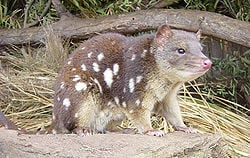Dasyuromorphia
| Dasyuromorphia
| ||||||||||||
|---|---|---|---|---|---|---|---|---|---|---|---|---|
 A quoll
| ||||||||||||
| Scientific classification | ||||||||||||
| ||||||||||||
The order Dasyuromorphia (meaning "hairy tail"[1]) comprises most of the Australian carnivorous marsupials, including quolls, dunnarts, the numbat, the Tasmanian devil, and the recently extinct thylacine. In Australia, the exceptions include the omnivorous bandicoots (order Peramelemorphia) and the marsupial moles (which eat meat but are very different and are now accorded an order of their own, Notoryctemorphia). Numerous South American species of marsupials (orders Didelphimorphia, Paucituberculata, and Microbiotheria) are also carnivorous.
There are three families: one with just a single member, one with only extinct members, including the late "Tasmanian Tiger" (Thylacine - Thylacinus cynocephalus), and one, Dasyuridae, with about 70 members.
Characteristics
Unlike herbivores, which tend to become highly specialized for particular ecological niches and diversify greatly in form, carnivores tend to be broadly similar to one another, certainly on the level of gross external form. Just as northern hemisphere carnivores like cats, foxes and weasels are much more alike in structure than, for example, camels, goats, pigs and giraffes, so too are the marsupial predators constrained to retain general-purpose, look-alike forms—forms which mirror those of placental carnivores. The names given to them by early European settlers reflect this: the Thylacine was called the Tasmanian Tiger, quolls were called native cats, and so on.
The primary specialisation among marsupial predators is that of size: prior to the massive environmental changes that came about with the arrival of humans about 50,000 years ago, there were several very large carnivores, none of them members of the Dasyuromorphia and all of them now extinct. Those that survived into historical times ranged from the wolf-sized Thylacine to the tiny Long-tailed Planigale which at 4 to 6 grams is less than half the size of a mouse. Most, however, tend towards the lower end of the size scale, typically between about 15 or 20 grams and about 2 kilograms, or from the size of a domestic mouse to that of a small domestic cat.
Classification
To provide context, the table below also shows the other major branches of the Australasian marsupial tree.
- Order Microbiotheria: (1 species, the Monito del Monte of South America)
- ORDER DASYUROMORPHIA
- Family †Thylacinidae
- †Thylacine Thylacinus cynocephalus
- Family Dasyuridae (72 species in 20 genera)
- Subfamily Dasyurinae: quolls, Kowari, Mulgara, little red kaluta, dibblers, phascogales, antechinuses, pseudantechinuses, and the Tasmanian devil
- Subfamily Sminthopsinae: dunnarts, the Kultarr, planigales and ningaui
- Family Myrmecobiidae
- Numbat Myrmecobius fasciatus
- Family †Thylacinidae
- Order Peramelemorphia (21 species: rainforest bandicoots, bandicoots, and bilbies)
- Order Notoryctemorphia (2 species of marsupial mole)
- Order Diprotodontia (about 137 species in 11 families, including the Koala, wombats, possums, potoroos, kangaroos, wallabies and others.)
Myrmecobiidae
Dasyuridae
Thylacinidae
ReferencesISBN links support NWE through referral fees
- C. Groves, "Order Primates," "Order Monotremata," (and select other orders). Page(s) 23-37 in D. E. Wilson and D. M. Reeder, eds., Mammal Species of the World, 3rd edition, Johns Hopkins University Press (2005). ISBN 0801882214.
External links
- Dasyuromorphia on Animal Diversity Web
| Mammals |
|---|
| Monotremata (platypus, echidnas) |
|
Marsupialia: | Paucituberculata (shrew opossums) | Didelphimorphia (opossums) | Microbiotheria | Notoryctemorphia (marsupial moles) | Dasyuromorphia (quolls and dunnarts) | Peramelemorphia (bilbies, bandicoots) | Diprotodontia (kangaroos and relatives) |
|
Placentalia: Cingulata (armadillos) | Pilosa (anteaters, sloths) | Afrosoricida (tenrecs, golden moles) | Macroscelidea (elephant shrews) | Tubulidentata (aardvark) | Hyracoidea (hyraxes) | Proboscidea (elephants) | Sirenia (dugongs, manatees) | Soricomorpha (shrews, moles) | Erinaceomorpha (hedgehogs and relatives) Chiroptera (bats) | Pholidota (pangolins)| Carnivora | Perissodactyla (odd-toed ungulates) | Artiodactyla (even-toed ungulates) | Cetacea (whales, dolphins) | Rodentia (rodents) | Lagomorpha (rabbits and relatives) | Scandentia (treeshrews) | Dermoptera (colugos) | Primates | |
Template:Dasyuromorphia
Credits
New World Encyclopedia writers and editors rewrote and completed the Wikipedia article in accordance with New World Encyclopedia standards. This article abides by terms of the Creative Commons CC-by-sa 3.0 License (CC-by-sa), which may be used and disseminated with proper attribution. Credit is due under the terms of this license that can reference both the New World Encyclopedia contributors and the selfless volunteer contributors of the Wikimedia Foundation. To cite this article click here for a list of acceptable citing formats.The history of earlier contributions by wikipedians is accessible to researchers here:
The history of this article since it was imported to New World Encyclopedia:
Note: Some restrictions may apply to use of individual images which are separately licensed.